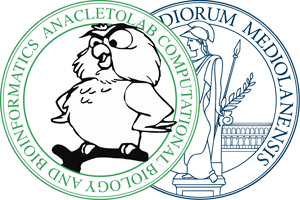
Matteo Re
Associate Professor
Email: matteo (dot) re (at) unimi (dot) it
Matteo Re is currently associate professor at the Department of Computer Science, University of Milan. His research interests belong to the areas of Machine Learning, Computational Biology and Bioinformatics. His work was focused, in the last years, on the following subjects: analysis development and application of supervised machine learning methods, analysis, development and application of semi-supervised node ranking and classification methods for the analysis of genes and drugs networks, development of drug networks integration methods, automated identification of protein-coding genomic regions and protein-coding mRNAs, development and analysis of semi-supervised methods for graph nodes ranking and classification, development of semi-supervised methods based on graph kernels and kernelized score functions for the analysis of large graphs.
Publications
M. Schubach, M. Re, P. Robinson and G. Valentini. Imbalance-aware machine learning for predicting rare and common disease-associated non-coding variants. Scientific reports, Nature Publishing Group 7(1), 2017.
M. Schubach, M. Re, P. Robinson and G. Valentini. Variant relevance prediction in extremely imbalanced training sets. F1000Research 6, 2017.
A. Petrini, M. Schubach, M. Re, M. Frasca, M. Mesiti, G. Grossi, T. Castrignanò, P. Robinson and G. Valentini. Parameters tuning boosts HyperSMURF predictions of rare deleterious non-coding genetic variants. PeerJ Preprints, PeerJ Inc. San Francisco, USA 5, 2017.
J. Gliozzo, P. Perlasca, M. Mesiti, E. Casiraghi, V. Vallacchi, E. Vergani, M. Frasca, G. Grossi, A. Petrini, M. Re, A. Paccanaro and G. Valentini. Network modeling of patients’ biomolecular profiles for clinical phenotype/outcome prediction. Scientific Reports, Nature Publishing, 2020.
G. Valentini, G. Armano, M. Frasca, J. Lin, M. Mesiti and M. Re. RANKS: a flexible tool for node label ranking and classification in biological networks. Bioinformatics, Oxford University Press 32(18), 2016.
M. Re, M. Mesiti and G. Valentini. An automated pipeline for multi-species protein function prediction from the UniProt Knowledgebase. Automated Function Prediction SIG-ISMB, 2014.
M. Re, M. Mesiti and G. Valentini. A fast ranking algorithm for predicting gene functions in biomolecular networks. IEEE/ACM Transactions on Computational Biology and Bioinformatics (TCBB), IEEE Computer Society Press 9(6), 2012.
M. Re and G. Valentini. Network-based drug ranking and repositioning with respect to DrugBank therapeutic categories. IEEE/ACM Transactions on Computational Biology and Bioinformatics, IEEE 10(6), 2013.
M. Re and G. Valentini. Large scale ranking and repositioning of drugs with respect to DrugBank therapeutic categories. International Symposium on Bioinformatics Research and Applications, 2012.
G. Valentini, A. Paccanaro, H. Caniza, A. Romero and M. Re. An extensive analysis of disease-gene associations using network integration and fast kernel-based gene prioritization methods. Artificial Intelligence in Medicine, Elsevier 61(2), 2014.
M. Re and G. Valentini. Cancer module genes ranking using kernelized score functions. BMC Bioinformatics, BioMed Central 13(14), 2012.
M. Re and G. Valentini. Random walking on functional interaction networks to rank genes involved in cancer. IFIP International Conference on Artificial Intelligence Applications and Innovations, 2012.
M. Re and G. Valentini. Genes prioritization with respect to Cancer Gene Modules using functional interaction network data.. NETTAB 2011 Workshop on Clinical Bioinformatics, 2011.
M. Frasca, A. Bertoni, M. Re and G. Valentini. A neural network algorithm for semi-supervised node label learning from unbalanced data. Neural Networks, Elsevier 43, 2013.
J. Lin, M. Mesiti, M. Re and G. Valentini. Within network learning on big graphs using secondary memory-based random walk kernels. International Workshop on Complex Networks and their Applications, 2016.
M. Mesiti, M. Re and G. Valentini. Think globally and solve locally: secondary memory-based network learning for automated multi-species function prediction. GigaScience, BioMed Central 3(1), 2014.
M. Mesiti, M. Re and G. Valentini. Scalable network-based learning methods for automated function prediction based on the neo4j graph-database. Proceedings of the Automated Function Prediction SIG 2013—ISMB Special Interest Group Meeting, 2013.
N. Zhou, Y. Jiang, [...], M. Frasca, M. Notaro, G. Grossi, A. Petrini, M. Re, G. Valentini, M. Mesiti and others. The CAFA challenge reports improved protein function prediction and new functional annotations for hundreds of genes through experimental screens. Genome Biology 20(1), 2019.
P. Robinson, M. Frasca, S. Köhler, M. Notaro, M. Re and G. Valentini. A hierarchical ensemble method for dag-structured taxonomies. International Workshop on Multiple Classifier Systems, 2015.
G. Valentini, S. Köhler, M. Re, M. Notaro and P. Robinson. Prediction of human gene-phenotype associations by exploiting the hierarchical structure of the human phenotype ontology. International Conference on Bioinformatics and Biomedical Engineering, 2015.
N. Cesa-Bianchi, M. Re and G. Valentini. Synergy of multi-label hierarchical ensembles, data fusion, and cost-sensitive methods for gene functional inference. Machine Learning, Springer 88(1-2), 2012.
M. Re and G. Valentini. An experimental comparison of Hierarchical Bayes and True Path Rule ensembles for protein function prediction. International Workshop on Multiple Classifier Systems, 2010.
N. Cesa-Bianchi, M. Re and G. Valentini. Functional inference in FunCat through the combination of hierarchical ensembles with data fusion methods. ICML Workshop on learning from Multi-Label Data MLD'10, 2010.
A. Rozza, G. Lombardi, M. Re, E. Casiraghi, G. Valentini and P. Campadelli. A novel ensemble technique for protein subcellular location prediction. Ensembles in Machine Learning Applications, Springer, 2011.
A. Rozza, G. Lombardi, M. Re, E. Casiraghi and G. Valentini. DDAG K-TIPCAC: an ensemble method for protein subcellular localization. ECML SUEMA 2010 workshop: supervised and unsupervised ensemble methods and their applications, 2010.
M. Re and G. Valentini. Simple ensemble methods are competitive with state-of-the-art data integration methods for gene function prediction.. MLSB, 2010.
M. Re and G. Valentini. Integration of heterogeneous data sources for gene function prediction using decision templates and ensembles of learning machines. Neurocomputing, Elsevier 73(7-9), 2010.
M. Re and G. Valentini. Ensemble based data fusion for gene function prediction. International Workshop on Multiple Classifier Systems, 2009.
R. Avogadri, M. Brioschi, F. Ferrazzi, M. Re, A. Beghini and G. Valentini. A stability-based algorithm to validate hierarchical clusters of genes. International Journal of Knowledge Engineering and Soft Data Paradigms, Inderscience Publishers 1(4), 2009.
M. Re, M. Mesiti and G. Valentini. Comparison of early and late omics data integration for cancer modules gene ranking. NETTAB: Integrated Bio-Search, 2012.
M. Re, M. Mesiti and G. Valentini. Drug repositioning through pharmacological spaces integration based on networks projections. EMBnet. journal 18(A), 2012.
A. Bertoni, M. Re, F. Saccà and G. Valentini. Identification of promoter regions in genomic sequences by 1-dimensional constraint clustering.. WIRN, 2011.
G. Valentini, A. Paccanaro, H. Vierci, A. Romero and M. Re. Network integration boosts disease gene prioritization. Network Biology SIG, 2013.
M. Re and G. Valentini. Predicting gene expression from heterogeneous data. International Meeting on Computational Intelligence Methods for Bioinformatics and Biostatistics (CIBB), 2009.
M. Re and G. Valentini. Prediction of gene function using ensembles of SVMs and heterogeneous data sources. Applications of supervised and unsupervised ensemble methods, Springer, 2009.
A. Beghini, F. Corlazzoli, L. Del Giacco, M. Re, F. Lazzaroni, M. Brioschi, G. Valentini, F. Ferrazzi, A. Ghilardi, M. Righi and Others. Regeneration-associated WNT signaling is activated in long-term reconstituting AC133bright acute myeloid leukemia cells. Neoplasia (New York, NY), Neoplasia Press 14(12), 2012.
G. Valentini and M. Re. Weighted True Path Rule: a multilabel hierarchical algorithm for gene function prediction. European Conference on Machine Learning and Principles and Practice of Knowledge Discovery in Databases: 1st International Workshop on learning from Multi-Label Data, 2009.
C. Ba, E. Casiraghi, M. Frasca, J. Gliozzo, G. Grossi, M. Mesiti, M. Notaro, P. Perlasca, A. Petrini, M. Re and Others. A Graphical Tool for the Exploration and Visual Analysis of Biomolecular Networks. International Meeting on Computational Intelligence Methods for Bioinformatics and Biostatistics, 2018.
J. Gliozzo, P. Perlasca, M. Mesiti, E. Casiraghi, V. Vallacchi, E. Vergani, M. Frasca, G. Grossi, A. Petrini, M. Re and Others. Network modeling of patients' biomolecular profiles for clinical phenotype/outcome prediction. Scientific reports, Nature Publishing Group 10(1), 2020.
A. Petrini, M. Mesiti, M. Schubach, M. Frasca, D. Danis, M. Re, G. Grossi, L. Cappelletti, T. Castrignanò, P. Robinson and Others. parSMURF, a high-performance computing tool for the genome-wide detection of pathogenic variants. GigaScience, Oxford University Press 9(5), 2020.
 AnacletoLAB
AnacletoLAB